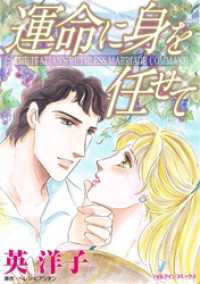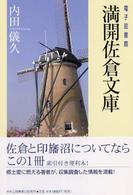- ホーム
- > 洋書
- > 英文書
- > Science / Mathematics
Full Description
The floricultural industry has been undergoing an unprecedented revolu tion in terms of the type of commodity produced and the production and marketing technology in both developed and developing countries. As a result of this revolution, as we know today, there is a flower for every purpose and for every person in the world, as is evident from the slogan of the Society for American Florists: "say it with flowers". In re cent years, the Latin American and European countries have become sizeable competitors for the North American fresh flower markets and the trend continues growing. Like any other crop production, floricultural production can be divided into three basic factors: (1) production costs (2) quality (3) transportation costs. All these must be optimum for this area or industry to be safe from competition. With increasing consumer awareness and the current recession, the pressure from the artificial floral products in dustry and also of neighbouring countries on the American fresh flower industry, and continued competition even amongst the growers, whole salers and retailers, quality in floricultural industry is becoming increas ingly important to all those concerned with handling these products. The visual quality aspects of the product are the sole determiner of consumer acceptability in this industry and, unlike fruits and vegetables, flowers cannot be marketed by just discarding the damaged portion.
Contents
1 Introduction.- 1.1 Production, Utilization and the International Trade.- 1.2 Future Trends in the Flower Industry.- 1.3 Quality in Flowers and Ornamentals.- 1.4 Postharvest Losses and Problems of Handling in Flowers and Ornamentals.- References.- 2 Senescence of Flowers and Ornamentals — Basic Principles and Considerations.- 2.1 Definition and Terminology.- 2.2 Structural, Biochemical and Metabolic Changes Associated with Senescence of Flowers and Ornamentals.- 2.3 Hormonal Regulation of Senescence of Flowers and Ornamentals.- 2.4 Shedding of Flowers and Ornamentals (Foliage).- 2.5 Concluding Remarks.- References.- 3 Carnation.- 3.1 Introduction.- 3.2 Physiology and Biochemistry.- 3.3 Postharvest Losses.- 3.4 Loss Reduction Biotechnology.- References.- 4 Rose.- 4.1 Introduction.- 4.2 Physiology and Biochemistry.- 4.3 Postharvest Losses.- 4.4 Loss Reduction Biotechnology.- 4.5 Vase Life Evaluation in Roses.- References.- 5 Chrysanthemum.- 5.1 Introduction.- 5.2 Physiology and Biochemistry.- 5.3 Postharvest Losses.- 5.4 Loss Reduction Biotechnology.- References.- 6 Tulip.- 6.1 Introduction.- 6.2 Physiology and Biochemistry.- 6.3 Postharvest Losses in Cut Tulips.- References.- 7 Orchid.- 7.1 Introduction.- 7.2 Physiology and Biochemistry.- 7.3 Postharvest Losses in Orchids.- 7.4 Loss Reduction Biotechnology.- References.- 8 Gladiolus.- 8.1 Introduction.- 8.2 Physiology and Biochemistry.- 8.3 Postharvest Losses in Cut Gladiolus.- 8.4 Loss Reduction Biotechnology.- References.- 9 Other Cut Flowers.- 9.1 Gerbera.- 9.2 Anthurium.- 9.3 Gypsophila.- 9.4 Iris.- 9.5 Narcissus.- 9.6 Snapdragon.- 9.7 Statice.- 9.8 Freesia.- 9.9 Delphinium.- 9.10 Stocks.- 9.11 Zantedechia.- 9.12 Paeonia.- 9.13 Anemone.- 9.14 Aster.- 9.15 Rananculus.- 9.16 Sterlitzia.- 9.17 Cut Greens.-References.- 10 Potted Plants.- 10.1 Chrysanthemum.- 10.2 Poinsettia.- 10.3 African Violets.- 10.4 Begonia.- 10.5 Geranium.- 10.6 Kalanchoe.- 10.7 Easter Lily.- 10.8 Cyclamen.- 10.9 Gloxinia.- 10.10 Calceolaria.- 10.11 Streptocarpus.- 10.12 Cineraria (Senecio hybridus).- 10.13 Rhododendron.- 10.14 Hydrangea.- References.- 11 Foliage Plants.- 11.1 Introduction.- 11.2 Physiology and Biochemistry.- 11.3 Post-Production Losses in Foliage Plants.- 11.4 Loss Reduction Biotechnology.- References.








